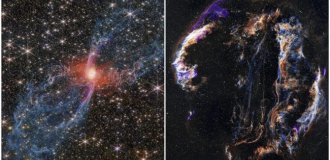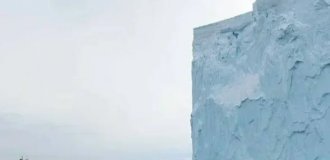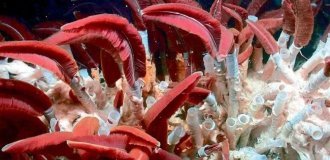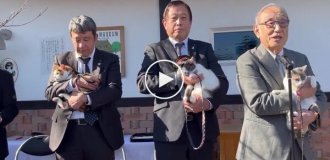Second Chernobyl. Dangerous mercury in Kyiv (100 photos + video)
Well, while the Issue is being prepared, we will talk about the bad. For the people of Kiev.
Second Chernobyl.































































































































Residents and guests of the capital do not even suspect that, walking along the streets of Kyiv, they are exposing themselves to mortal danger. If you analyze the most dangerous objects, you may get the impression that Kyiv was specially stuffed with chemical “mines,” writes today “
". Thus, in the area of the Lesnaya metro station, the ground is saturated with mercury several meters deep. In Akademgorodok there are reserves of a deadly metal, and the museum in Pirogovo stands two steps from a radioactive burial ground. But the saddest thing is that no one is close to potentially dangerous objects no matter, the newspaper states.
Let's start in the area of the Lesnaya metro station. The 200 tons of mercury that seeped into the soil and foundations of the buildings of the former Radikal plant seem to be of no interest to anyone. Since 1954, mercury has been used there to produce caustic soda, and imperfect technology suggested the presence of so-called “planned leaks.”
Today the plant as such no longer exists: it has been declared bankrupt, and its buildings, located near the Lesnaya metro station, are occupied by numerous offices and small enterprises. There is a market adjacent to the plant. New owners of factory buildings are reluctant to answer questions about mercury, the newspaper writes.
Entrepreneurs say: “We have permission to work in this premises, which means that the sanitary services believe that everything is in order. But what can be done with mercury that has penetrated several meters into the ground?”
The head of the information center of the UEA "Green World" Sergei Fedorinchyk expressed his opinion: “I think that no serious detoxification was carried out at Radical. Mercury has ingrained here not only into the ground, but also into the walls. Of course, there are ways to deal with this, but "The task of serious cleaning was simply not set. And at Radical in the fifties they also produced dust, tons of this powerful carcinogen are still scattered throughout the territory today."
It should be noted that all sorts of “chemical emergencies” are associated with “Radical”: for example, nine kilograms of mercury recently spilled from a leaky truck at the entrance of the plant. And the authorities’ promises to transport the contaminated soil to a burial ground in Donbass (the official city newspaper Khreshchatyk reported about them) are unlikely to be realized. In any case, as Sergei Fedorinchik told us, in Nikitovka, where there was once a mercury plant, no mercury waste is now accepted for processing.
Let us now move to another district of the capital - Akademgorodok. There is enough beryllium here to poison the whole of Ukraine. Beryllium is an extremely toxic element, the maximum permissible concentration of dust or vapor in the air is only 0.001 mg/m3. Inhalation of beryllium dust leads to the deadly pulmonary disease beryllium, and its presence in the air can only be determined with the help of a special chemical laboratory, which currently does not even have money for reagents. 111 containers with beryllium have been stored for 20 years in the middle of residential areas of Akademgorodok - on the territory of the former secret Zapad plant.
The chief engineer of the plant, Nikolai Tishchenko, has repeatedly written to the Cabinet of Ministers asking for help to pay off the company’s debts, including wages, which workers have not seen for the second year. “Once upon a time, the secret Zapad plant worked “for Space.” Beryllium was needed because it is one and a half times lighter than aluminum and at the same time stronger than many special steels. After the collapse of the USSR, production was curtailed, and dust, tiles from the workshops, tools - everything was collected in containers and left in the former workshop,” explained the chief engineer.
The containers of beryllium - approximately three by three meters, black metal boxes - are stacked in several rows in a cold room with dim light bulbs, puddles of water on the floor and fire alarm wires. If you don’t know what danger is hidden here, you might think that you are in an ordinary warehouse. There is still life in the neighboring workshops.
According to Nikolai Tishchenko, “approximately 13 million hryvnia are needed to remove and bury the containers. There is none. A number of employees have been leaving since the end of March. Perhaps soon there will simply be no one to even guard the containers with beryllium.”
And finally, about the museum in Pirogovo. A resonance accident involving the release of radioactive elements into the environment occurred back in 1995, when traces of “phoning” tritium were discovered in the Vita River. It was then that the people of Kiev learned about the existence of a radioactive waste repository in Pirogovo. Which today receives radioactive waste from industry and medicine from six neighboring regions.
The director of the plant, Vladimir Andrievsky, assures: “After that accident, three waste storage facilities were decommissioned, and a shelter was built over them. But the elimination of the consequences continues now: at the expense of the city administration, we remove and transport contaminated waste. However, if this work suddenly stops, radioactive isotopes will again will be able to appear not only in Vita, but also in Dnieper."
According to Vladimir Zakharovich, from the Ministry of Emergency Situations, to which Radon reports, the company received money only for salaries. Not a penny was transferred for energy resources, taxes, or to support the normal operation of the special plant.
“We are promised that as soon as the Vector complex is put into operation near Chernobyl, our waste will be transferred from Kyiv there. But when this will happen is unknown. Meanwhile, if funding does not start flowing in a month, the normal functioning of the complex will be in jeopardy ", he says.
WHERE THE DANGEROUS MAST LIES IN Kyiv
- Enterprise "Zapad" (Vernadskogo Ave., 38): containers with toxic beryllium;
- JSC "Kievryba" (62 Vozdukhoflotsky Ave.): several years ago there was an accident with an ammonia release;
- Special plant "Radon" (Pirogovo village, Kommunalnaya str., 1): radioactive waste;
- Cold storage plant No. 4 (Ak. Biletsky St., 34): ammonia is used in production;
- Cold storage plant No. 2 (Krasnoarmeisky village): ammonia is used in production;
- Dnieper water station (DVS village): chlorine and ammonia are used in the cleaning process, an additional risk factor is worn-out equipment;
- Desnyanskaya water station (Navoi Ave., 1): chlorine and ammonia are used in the cleaning process, an additional risk factor is worn-out equipment;
- Radikal plant (near the Lesnaya metro station): mercury that penetrated several meters into the ground;
- Bortnicheskaya aeration station: sludge from settling tanks is a potential breeding ground for typhoid, dysentery, and it also contains toxic substances;
- .Institute of Physical Chemistry (Nauki Ave., 31): radioactive cobalt waste.
On the left bank outskirts of Kyiv, large deposits of mercury were discovered in the open air, dangerous to the lives of not only residents of the Lesnoy massif, but also the entire city, especially in the summer. A video showing soil on the territory of the Radikal plant, “saturated” with balls of a dangerous substance, appeared on May 5 on several metropolitan Internet forums. Two days later, the Kiyani website published information that someone was stealing mercury from a bankrupt plant (near the Lesnaya metro station), as evidenced by freshly dug ditches designed to drain the toxic substance.
The situation at the Radikal plant is “consistently threatening” and has not changed in recent years, Vladimir Boreyko, head of the Kyiv Ecological and Cultural Center, shared his observations with the online newspaper “NOW”. According to him, information about the presence of large deposits of mercury in the open air on the territory of the enterprise has been received by environmentalists since 1996 and has been repeatedly confirmed. This means that people located within a radius of several hundred kilometers are in danger.
Problem No. 2, according to Boreyko, is that construction is about to begin on land saturated with a toxic substance. According to his information, the lands around the plant have already been allocated for the construction of a new residential microdistrict without conducting an environmental assessment and reclamation (artificial restoration of soil fertility).
“Land that has been under the influence of heavy metals for a very long time cannot be so easily allocated for development, not to mention for people to live there and build kindergartens,” the ecologist noted.
How much mercury is located on the territory of “Radical” is a sealed secret. Attempts by environmentalists to obtain this information were unsuccessful. A year ago, the Ministry of Emergency Situations issued an order to classify information at such government institutions.
The Ministry of Environmental Protection, which is authorized to conduct an examination, could help, Boreyko continued. To do this, according to the Law “On Environmental Expertise”, only the initiative of the Cabinet of Ministers, local authorities or public organizations is sufficient.
Since time is pressing, the ecologist called on local residents to organize initiative groups and seek to carry out the examination on their own.
Stop panicking!
It turned out to be difficult to obtain official comments from representatives of the capital’s authorities on this case.
The head of the Department for the Protection of Population and Territories of the Main Directorate for Emergency Situations of the Kyiv City State Administration, Alexander Ryabchuk, who oversees the “mercury” topic on “Radical,” assured that “there is no difficult situation,” unverified information is being disseminated. “Everything is under control, no work is being carried out there, no one is doing anything. Nothing terrible is happening in the city,” the official said. He refused to provide more detailed information, citing a management ban.
At the capital's sanitary and epidemiological station, the NOW correspondent was redirected several times from official to official, after which they refused to comment, citing the absence of the head on site.
Time bomb?
Pollution of the environment with toxic mercury vapor has been going on for several years. City authorities ask not to panic, assuring that everything is “normal.” Thus, in June 2007, on Krasnotkatskaya Street (Desnyansky district), a spill of 9 kg of mercury occurred from a container that was transported in his own ZIL by a resident of the village of Vishnevoye, Kyiv region. According to the district prosecutor's office, the damaged container was transferred to a KamAZ truck, which fled in an unknown direction.
Over four years - from 2001 to 2005 - 120 tons of free mercury were collected on the territory of "Radikal", said the commander of the Kharkov operational rescue service, Yuriy Kulish. According to him, this is a colossal amount of toxic substance. The discovery of 0.5 kg of mercury is already considered a national emergency. At Radical, rescuers collected 600 tons of mercury-contaminated metals and slags, neutralized 300 tons of acids with impurities of organochlorine compounds and 500 tons of bertholite salt. Rescuers do not know how many toxic substances are currently located on the territory of the plant.
Help:
Mercury is an enzyme poison with an affinity for thiol groups. Acute poisoning with metallic mercury (vapor) causes inflammation of the respiratory tract with the development of interstitial pneumonitis leading to respiratory failure. The rapid entry of mercury vapor into the central nervous system causes associated symptoms, including tremors and increased excitability.
Chronic mercury vapor poisoning primarily affects the central nervous system. Initial symptoms include fatigue, anorexia, weight loss and gastrointestinal distress. An increase in the duration of exposure or the concentration of vapors causes the appearance of a characteristic trembling of the hands during voluntary movement, characteristic of mercury poisoning.
Chronic inorganic mercury poisoning also causes the neurological changes described above and is characterized by excessive salivation, tooth loss, gingivitis and stomatitis. When exposed to skin, mercury salts can cause hypersensitivity reactions ranging from mild erythema to severe scaly dermatitis. Acrodynia, or pink disease, occurs in young children and may be mistaken for Kawasaki disease.
Chronic poisoning is also characterized by a generalized rash, irritability, photophobia, hypertrichosis and profuse sweating, accompanied by desquamation of the skin of the feet and hands. In this case, hyperkeratosis of the skin and swelling of the hands and feet may occur.





















